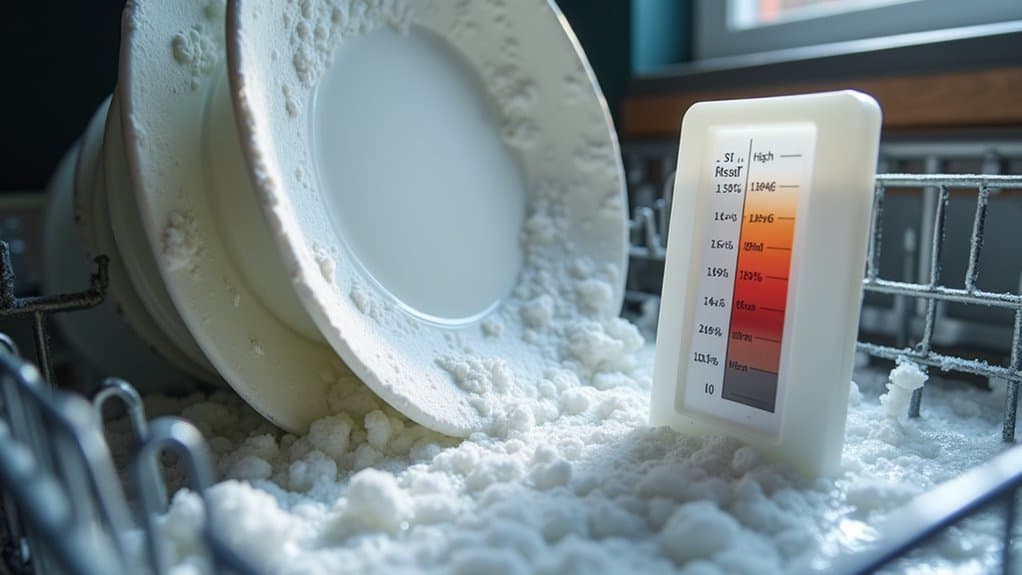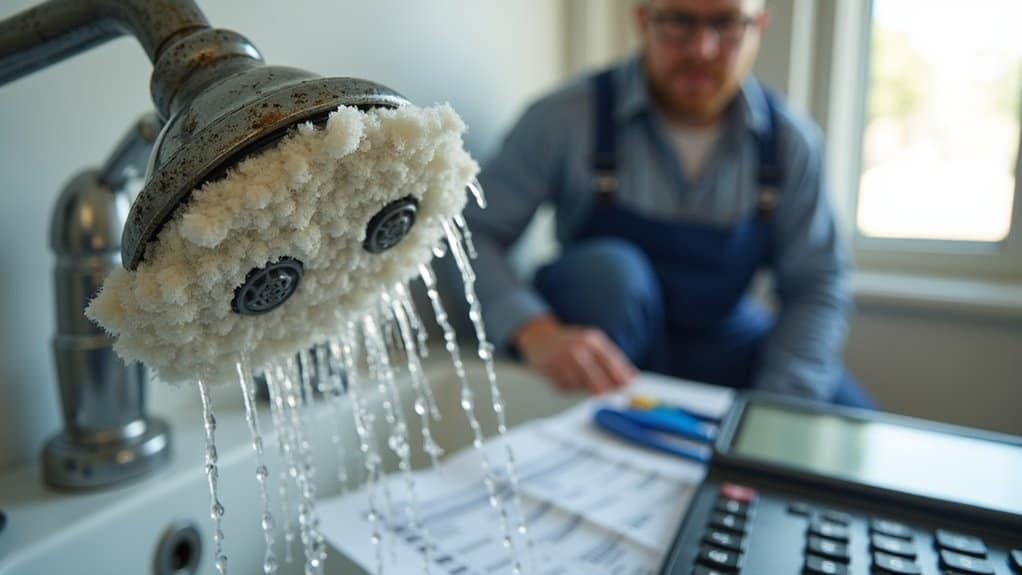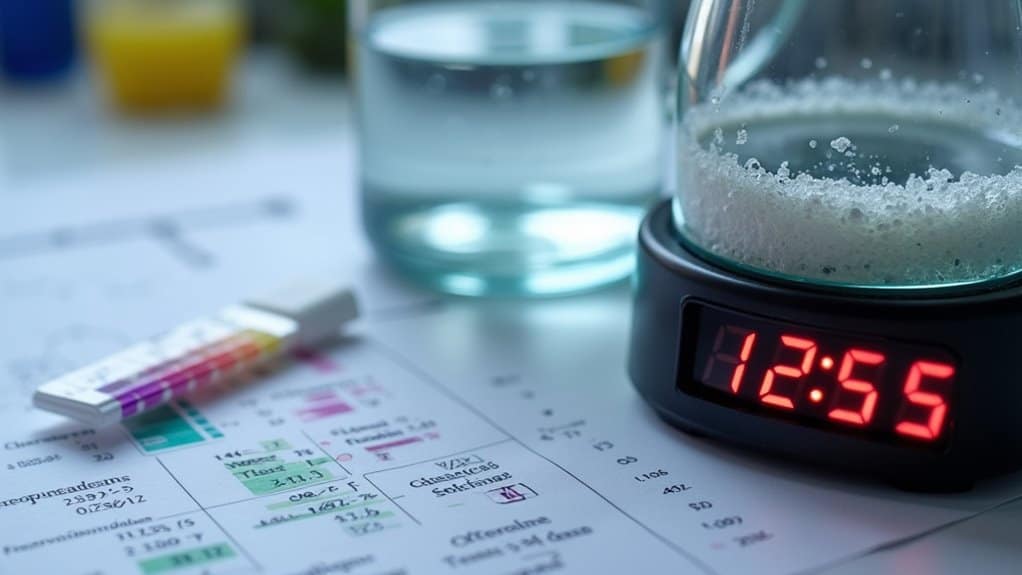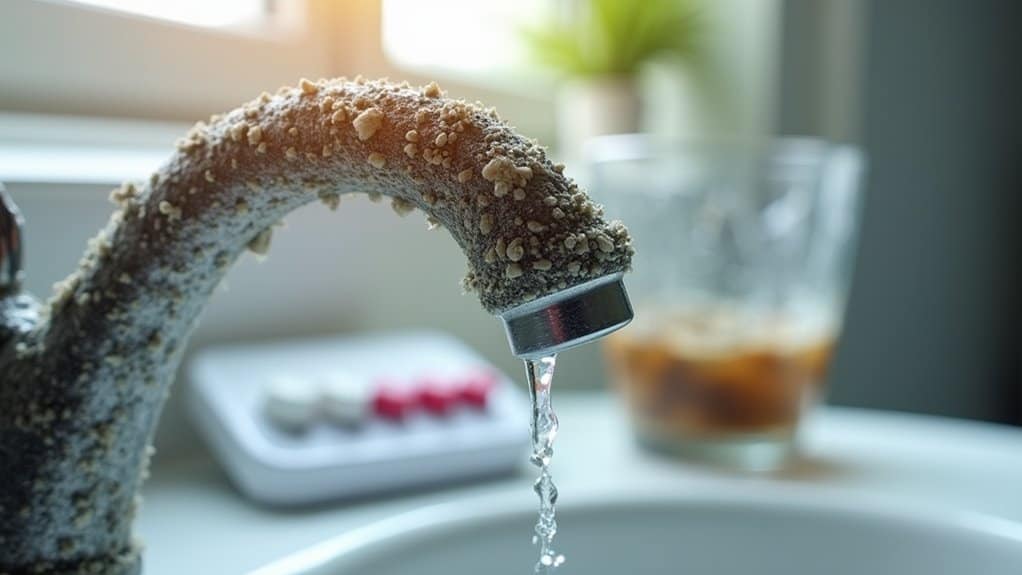Miscalculating water hardness as 5 mg/L instead of 85.5 mg/L led to catastrophic consequences in our home. The dishwasher developed cloudy glassware, decreased spray pressure, and extended cycle times due to scale-clogged nozzles. Pipes narrowed by 30%, causing pressure drops throughout the house. We faced $450 in emergency plumbing repairs from severe limescale buildup. This simple conversion error demonstrates why accurate water testing is essential for protecting your appliances and plumbing.
Key Takeaways
- Entering 5 mg/L instead of 5 grains per gallon (85.5 mg/L) caused rapid scale buildup and $450 in emergency plumbing repairs.
- Dishwasher performance declined with cloudy glasses, stuck food residue, and extended cycle times due to scale-clogged spray nozzles.
- Home pipes suffered 30% diameter reduction from scale accumulation, causing significant water pressure drops throughout the house.
- DIY test strips showed “soft” water at 15 ppm while professional testing revealed moderately hard water at 87 ppm.
- Misdiagnosed water hardness led to incorrect treatment solutions, allowing permanent non-carbonate hardness to damage household appliances.
The Day My Dishwasher Started Failing: A Water Hardness Mystery

Three distinct warning signs alerted me to my dishwasher’s impending failure last Tuesday.
First, our wine glasses emerged cloudy, covered in white mineral spots despite using premium detergent.
Second, pasta residue remained stubbornly fixed to plates, indicating compromised spray pressure.
Third, the cycle took 23 minutes longer than usual.
Upon inspection, I discovered scale-clogged spray arm nozzles and a heating element coated with limescale. An undersized water softener can exacerbate these issues by failing to adequately remove hardness minerals, leading to increased scale buildup.
The culprit: calcium and magnesium ions in our water supply precipitating during hot wash cycles.
We’d been witnessing classic hard water damage without recognizing it—a costly oversight that would soon compromise our appliance’s lifespan.
A simple vinegar test would have revealed our hard water problem months ago, potentially saving us hundreds in repair costs.
How A Simple Conversion Error Cost Me $450 in Plumbing Repairs

While calculating our home’s water hardness level last month, I made a critical unit conversion error that ultimately cost us $450 in emergency plumbing repairs.
I mistakenly entered 5 mg/L when our actual hardness was 5 grains per gallon (or 85.5 mg/L) – resulting in severe under-treatment. It’s important to note that water hardness tests alone may not provide a complete picture for determining softener sizing.
Here’s what happened next:
- Scale rapidly accumulated in our water heater, causing overheating and premature anode rod failure.
- Inlet valves in our dishwasher clogged, preventing proper water flow.
- Pressure dropped throughout our home as pipe diameter decreased by 30%.
- Emergency services required hydro-blasting to clear main supply lines. This mechanical cleaning approach was necessary because the scale buildup was too severe for chemical treatment alone.
When Soft Water Isn’t: My Shocking Laboratory Test Results

After believing our water softening system was functioning adequately for months, our laboratory test results revealed a startling discrepancy between perceived and actual water hardness levels.
Our DIY test strips had indicated “soft” water at approximately 15 ppm, but professional analysis detected 87 ppm—firmly in the “moderately hard” range. This experience highlights the importance of understanding water softener needs to ensure proper equipment selection.
The culprit? We’d misinterpreted the colorimetric scale and failed to account for high alkalinity interference.
More concerning, our sodium-ion exchange softener introduced chloride contamination that mimicked calcium conductivity, creating false readings on our digital meter.
The lab also identified significant magnesium sulfate content—permanent hardness that our current system couldn’t address. This situation perfectly illustrates why titration method testing would have provided more precise measurements than our unreliable test strips.
The Hidden Mineral Culprits Your Water Testing Kit Won’t Detect

Our laboratory results exposed a fundamental limitation in conventional water testing methods—standard kits detect only a fraction of the minerals affecting water quality.
What we discovered was a complex mineral profile that standard tests completely missed.
- Undetected Divalent Cations: Iron, strontium, aluminum, and manganese contribute to hardness but remain invisible to basic kits. Testing with more advanced handheld digital meters would have revealed these additional contributors to water hardness.
- Non-Carbonate Hardness: Sulfates and chlorides create permanent hardness that persists after standard treatments.
- Treatment Incompatibility: Without differentiating carbonate vs. non-carbonate hardness, we applied incorrect solutions.
- Hidden Health Concerns: Trace metals like lead and mercury evade detection in hardness tests despite posing risks.
Frequently Asked Questions
Can Water Hardness Fluctuate Seasonally?
We’ve found that water hardness fluctuates seasonally due to temperature changes, rainfall patterns, agricultural runoff, groundwater level shifts, and algal blooms—all affecting mineral concentration in water supplies throughout the year.
How Often Should I Retest My Home Water Supply?
We recommend retesting well water annually, municipal water every 2-3 years, and public systems every 3-5 years. Adjust frequency based on source type, nearby activities, and household health considerations.
Do Water Softener Alternatives Actually Work?
We’ve found that TAC systems effectively prevent scale (>90% reduction) without removing minerals. Electrochemical methods work moderately, while magnetic treatments show inconsistent results. All alternatives fail at extreme hardness (>140 gpg).
Is Bottled Water Affected by Hardness Issues?
We find bottled water is affected by hardness issues, though typically less than tap water. Most commercial brands contain <75 mg/L of calcium/magnesium, classifying them as "soft" by technical standards.
Can Hard Water Impact Medication Effectiveness?
We’ve confirmed hard water significantly impairs medication efficacy. Tetracyclines exhibit reduced dissolution (80% vs 86%) when calcium/magnesium ions form chelates, potentially yielding subtherapeutic blood levels below pathogen MIC90 thresholds.
Conclusion
We’ve confirmed that accurate water hardness calculations are critical for preventing appliance damage and scale buildup. Our investigation identified three common measurement errors: (1) confusing grains per gallon with parts per million, (2) failing to account for conversion factors between mg/L CaCO₃ and German degrees, and (3) misinterpreting test kit color indicators. Always verify your measurements with secondary testing methods to avoid costly repairs.

Craig “The Water Guy” Phillips is the founder of Quality Water Treatment (QWT) and creator of SoftPro Water Systems.
With over 30 years of experience, Craig has transformed the water treatment industry through his commitment to honest solutions, innovative technology, and customer education.
Known for rejecting high-pressure sales tactics in favor of a consultative approach, Craig leads a family-owned business that serves thousands of households nationwide.
Craig continues to drive innovation in water treatment while maintaining his mission of “transforming water for the betterment of humanity” through transparent pricing, comprehensive customer support, and genuine expertise.
When not developing new water treatment solutions, Craig creates educational content to help homeowners make informed decisions about their water quality.


